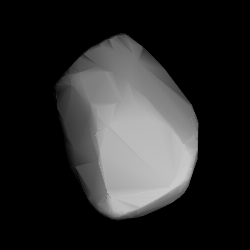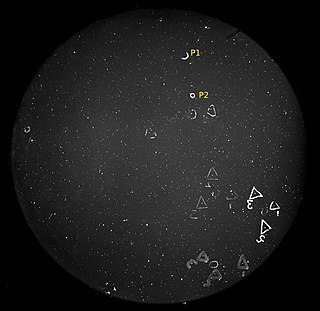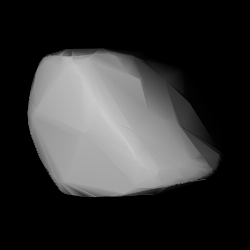Related Research Articles

15017 Cuppy, provisional designation 1998 SS25, is a Florian asteroid from the inner regions of the asteroid belt, approximately 2 kilometers in diameter. It was discovered on 22 September 1998, by the Lowell Observatory Near-Earth-Object Search (LONEOS) at its Anderson Mesa Station, Arizona, United States. The asteroid was named for American humorist Will Cuppy.

1997 Leverrier is a stony Flora asteroid from the inner regions of the asteroid belt. It was discovered on 14 September 1963, by the Indiana Asteroid Program at Goethe Link Observatory near Brooklyn, Indiana, United States, and named after French mathematician Urbain Le Verrier. The asteroid has a rotation period of 6.8 hours and measures approximately 7 kilometers in diameter

1740 Paavo Nurmi, provisional designation 1939 UA, is rare-type asteroid from the inner regions of the asteroid belt, approximately 13 kilometers in diameter.
5160 Camoes, provisional designation 1979 YO, is an asteroid from the inner regions of the asteroid belt, approximately 6 kilometers in diameter. The asteroid was discovered on 23 December 1979, by Belgian astronomer Henri Debehogne and Brazilian astronomer Edgar Netto at ESO's La Silla Observatory in northern Chile. It was later named for Portuguese poet Luís de Camões.
1800 Aguilar, provisional designation 1950 RJ, is a stony Vestian asteroid from the inner regions of the asteroid belt, approximately 8 kilometers in diameter.

1905 Ambartsumian, provisional designation 1972 JZ, is an asteroid from the inner regions of the asteroid belt, approximately 8 kilometers in diameter. It was discovered on 14 May 1972, by Russian astronomer Tamara Smirnova at the Crimean Astrophysical Observatory, Nauchnyj, on the Crimean peninsula. The asteroid was named after theoretical astrophysicist Victor Ambartsumian.
2572 Annschnell, provisional designation 1950 DL, is a background asteroid from the inner regions of the asteroid belt, approximately 10 kilometers in diameter.
1713 Bancilhon, provisional designation 1951 SC, is an asteroid from the inner regions of the asteroid belt, approximately 5.7 kilometers in diameter.
7675 Gorizia, provisional designation 1995 WT5, is a background asteroid from the inner regions of the asteroid belt, approximately 3 kilometers in diameter. It was discovered on 23 November 1995, by the staff at Farra d'Isonzo Observatory in northeastern Italy. It is named for the Italian town of Gorizia.
1739 Meyermann, provisional designation 1939 PF, is a stony Florian asteroid from the inner regions of the asteroid belt, approximately 7.5 kilometers in diameter. It was discovered by German astronomer Karl Reinmuth at Heidelberg Observatory on 15 August 1939. It was later named in memory of astronomer Bruno Meyermann.
2056 Nancy, provisional designation A909 TB, is a stony background asteroid from the inner regions of the asteroid belt, approximately 10 kilometers in diameter. It was discovered on 15 October 1909, by German astronomer Joseph Helffrich at Heidelberg Observatory in southwest Germany. The S-type asteroid has a tentative rotation period of 15.0 hours. It was named for Nancy Marsden, wife of British astronomer Brian G. Marsden.
1857 Parchomenko, provisional designation 1971 QS1, is a stony asteroid and suspected binary from the inner regions of the asteroid belt, approximately 8 kilometers in diameter.
1807 Slovakia, provisional designation 1971 QA, is a stony asteroid and slow rotator from the inner regions of the asteroid belt, approximately 9 kilometers in diameter. It was discovered on 20 August 1971, by Slovak astronomer Milan Antal at Skalnaté pleso Observatory in the High Tatras mountains of Slovakia and named after the Slovak Republic.

1781 Van Biesbroeck is a Vesta asteroid from the inner regions of the asteroid belt, approximately 8.5 kilometers in diameter. It was discovered on 17 October 1906, by German astronomer August Kopff at Heidelberg Observatory in southern Germany. It was named after astronomer George Van Biesbroeck.

1704 Wachmann, provisional designation A924 EE, is a stony asteroid from the inner regions of the asteroid belt, approximately 7 kilometers in diameter. It was discovered by German astronomer Karl Reinmuth at Heidelberg Observatory on 7 March 1924. It was later named after astronomer Arno Wachmann.
2661 Bydžovský, provisional designation 1982 FC1, is an asteroid from the outer region of the asteroid belt, approximately 30 kilometers in diameter. It was discovered on 23 March 1982, by Czech astronomer Zdeňka Vávrová at the South Bohemian Kleť Observatory in the Czech Republic. The asteroid was named after mathematician Bohumil Bydžovský.
1530 Rantaseppä, provisional designation 1938 SG, is a stony Florian asteroid from the inner regions of the asteroid belt, approximately 5 kilometers in diameter. Discovered by Yrjö Väisälä at Turku Observatory in 1938, it was later named after Finnish astronomer Hilkka Rantaseppä-Helenius.
1779 Paraná, provisional designation 1950 LZ, is an asteroid from the inner regions of the asteroid belt, approximately 4 kilometers in diameter.
37432 Piszkéstető (provisional designation 2002 AE11) is an Erigonian asteroid from the inner regions of the asteroid belt, approximately 4.6 kilometers (2.9 miles) in diameter. It was discovered on 11 January 2002, by the Hungarian astronomers Krisztián Sárneczky and Zsuzsanna Heiner at the Konkoly Observatory's Piszkéstető Station northeast of Budapest, Hungary. The asteroid was later named for the discovering observatory.
2011 Veteraniya, provisional designation 1970 QB1, is a stony Vestian asteroid from the inner regions of the asteroid belt, approximately 6 kilometers in diameter. It was discovered on 30 August 1970, by Soviet astronomer Tamara Smirnova at the Crimean Astrophysical Observatory, Nauchnyj, on the Crimean peninsula, and named for the Soviet veterans of the Second World War.
References
- 1 2 3 4 "JPL Small-Body Database Browser: 1818 Brahms (1939 PE)" (2017-03-14 last obs.). Jet Propulsion Laboratory . Retrieved 8 June 2017.
- 1 2 3 Schmadel, Lutz D. (2007). "(1818) Brahms". Dictionary of Minor Planet Names. Springer Berlin Heidelberg. p. 145. doi:10.1007/978-3-540-29925-7_1819. ISBN 978-3-540-00238-3.
- 1 2 3 "Asteroid Size Estimator". CNEOS – NASA/JPL. Retrieved 9 November 2017.
- 1 2 "1818 Brahms (1939 PE)". Minor Planet Center. Retrieved 15 December 2016.
- ↑ Schmadel, Lutz D. "Appendix – Publication Dates of the MPCs". Dictionary of Minor Planet Names – Addendum to Fifth Edition (2006–2008). Springer Berlin Heidelberg. p. 221. doi:10.1007/978-3-642-01965-4. ISBN 978-3-642-01964-7.